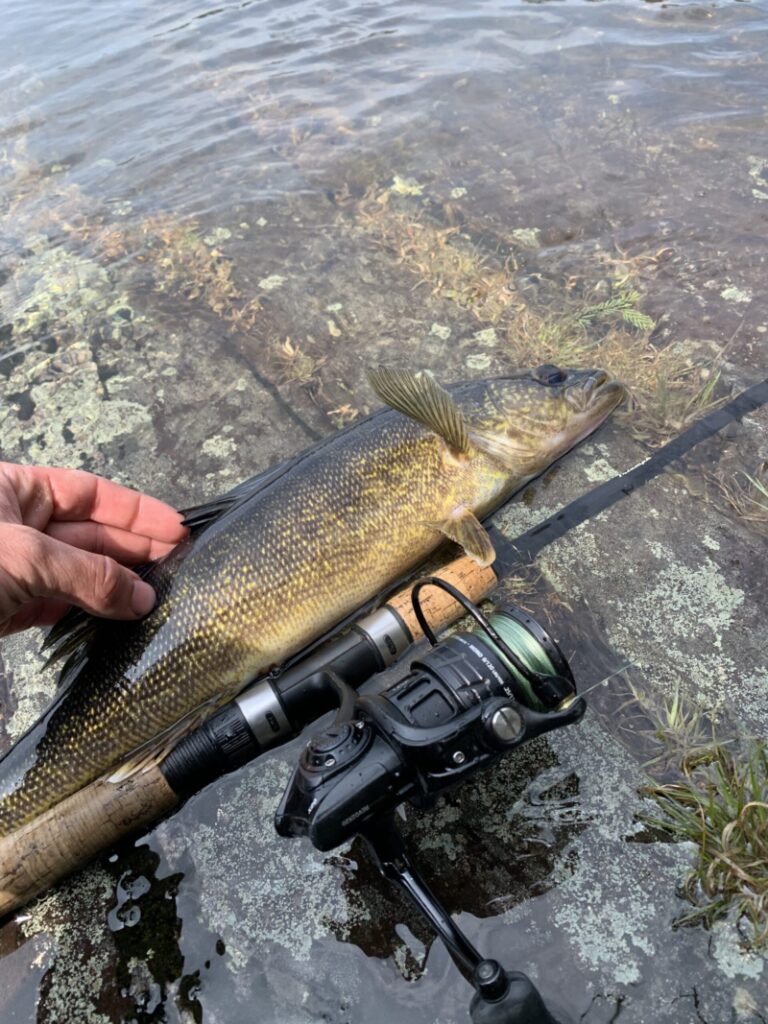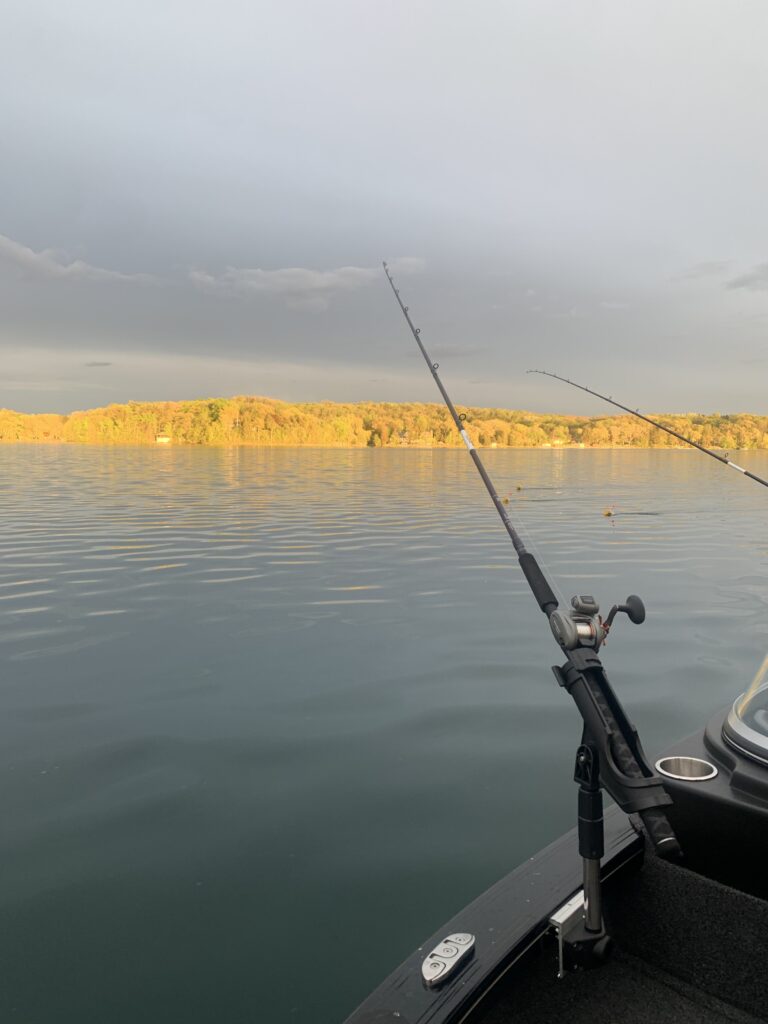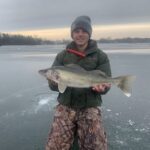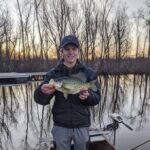Hey there fellow anglers! As the temperatures rise and the dog days set in, it’s that time of the year again – summer walleye fishing season! Whether you’re a seasoned pro or just starting out, this article has got you covered with everything you need to know to target walleye during the summer months. So grab your fishing gear and let’s dive into the world of summer walleye fishing.
As always, fishing education and conservation are our priorities here at The Angler’s Line. Feel free to sign up for our free newsletter to join our community and stay up to date! Lets get started!
Table of Contents:
- Summer Walleye Behavior
- Walleye Fishing Gear
- Lures For the Summertime
- Summer Walleye Location
- Fishing Techniques
- Bonus Tips
- Conservation
Understanding Summer Walleye Behavior
First things first, its important to understand walleye behavior during the summer before fishing for them.
Migration Patterns
During the summer, the walleye tend to make a move to the deeper main lake structures. When I say main lake structures, I am talking about structures that are close to a lakes basin and disconnected from the shoreline. As water temperatures rise, this deeper water tends to stay cooler and offers more oxygen and life overall. Keep in mind that there are some walleye that stay shallow and remain on weed flats and edges throughout the summer for the same reasons. Vegetation provides shade and oxygen when the temperatures rise.
Feeding Habits
In the summer, water temperatures are warm. Despite what many say, walleye need to feed heavily in this warmer water since their metabolisms are high. Walleye are opportunistic feeders, meaning that there is not one answer as to what walleye feed on during the summer. It is important to understand walleye forage and identify what specific type of forage is prevalent in your body of water throughout the summer.
Walleye Fishing Gear
To enhance your experience on your next summer walleye fishing outing, you’ll need the right gear. Let’s take a closer look at the essential equipment and tackle choices that will give you an edge.
Walleye Rods
Spinning: When it comes to the proper spinning rod for walleye, I recommend choosing a medium-light to medium power spinning rod with a fast action tip. As for as length goes, a rod between 6.5′ and 7.5′ is a good starting point for almost all walleye fishing applications. This provides enough sensitivity needed to detect subtle strikes and enough backbone to set the hook and control the fight.
Trolling: Trolling comes into play a lot when fishing for walleye in the summer. When it comes to trolling rods for walleye, I recommend rods between 6-9 feet in length. As you get more experienced, get varying lengths of trolling rods and put the longer rods towards the bow and shorter rods towards the stern. A medium power rod is a good starting point for a trolling rod and will cover most walleye applications.
Walleye Reels
Pair your spinning rod with a 2000 of 3000 size walleye spinning reel of your choice that has a smooth and reliable drag system. If you plan on trolling, this is a good technique to incorporate a baitcasting reel into your walleye fishing arsenal. Some baitcasters come equipped with a line-counter which is a nice added bonus for trolling.

Line and Leader Recommendations
For most summer walleye fishing techniques, I am an advocate for using a braided main line with a fluorocarbon leader. Remember that walleye fishing in the summer typically requires aggressive techniques. Braided line has a thinner line diameter than fluorocarbon, so you can get away with a slightly heavier pound test. For braid, choose between a 10 lb-20 lb test. For fluorocarbon, opt for a line between 6 lb- 12 lb. One exception to this is crankbaits. If you plan on using crankbaits, you are much better off running a monofilament line for the added stretch and forgiveness. Like fluorocarbon, choose monofilament between 6 lb – 12 lb.
Best Walleye Lures For The Summer
When it comes to lures, there’s a wide range of options to choose from. Crankbaits, live bait, and soft plastics are all effective choices for fall walleye fishing.
Crankbaits
Many walleye anglers are familiar with crankbaits for their effectiveness in the summer months. You can choose to either troll crankbaits or cast crankbaits. Either way, crankbaits allow you to fish quickly and cover lots of water. This is extremely important when fish are spread out like they tend to be in the summer. The crankbait that you choose is highly dependent on the depth you are fishing. In the summer, this is typically a crankbait that dives between 15-25 feet. Choose a crankbait that runs within a few feet of the bottom without constantly hanging up.
Bonus Tip: In order to maximize catch and release success with crankbaits, use barbless treble hooks or remove the front treble.
Live Bait
Live bait is a staple when it comes to walleye fishing, and summer is no different. Nightcrawlers are a very popular live bait option for walleye when the water temperatures are warm. One of my favorite ways to fish nightcrawlers is with a jig. The jig and crawler rig is about as simple as it gets, but deadly for summertime walleye. Minnows come into play during the late summer as well once fry and other baitfish start to school up. Minnows work well on slip bobbers or jigs.
Soft Plastics
Soft plastics are excellent options for walleye fishing during the summer since they can be fished very quickly and aggressively. Remember that the water is warm and all of the bait and fish are moving quickly and erratically. Soft plastics do a great job of mimicking this. Two of my favorite styles of soft plastics to use are paddle tails swimbaits and straight tail minnows. Pair these soft plastics with a heavier jig head than you would typically use for the depth you are fishing. Use a snap jigging retrieve and trigger walleye into striking. Remember that this is not a feeding response, but rather a reaction strike.
Finding the Best Spots: Summer Walleye Location
To find concentrations of walleye in the summer, you’ll need to focus your efforts in the right areas. Let’s explore some key hotspots where you’re likely to encounter them.
Main Lake Structures
Main lake structures are pieces of structure that are close to the lakes basin. This includes points, humps, and steep breaks the butt up against some of the deeper water a lake has to offer. Look for structure that has weeds or rock on them since these places are most likely to hold the most bait.
Deep Flats
A lot of anglers overlook flats when it comes to walleye fishing. The truth is, flats hold a lot of fish. The key is to find the depth that the walleye are relating to. Use your depth finder for this. If you see that walleye are relating to 18 feet, look for flats that are around that same depth. Flats are generally large areas, so use techniques like trolling or snap jigging to cover a lot of water and find fish.
Weed Edges
Weed edges are great places to find walleye year round, but it is important to know how walleye use weed edges during the summer. Typically, walleye hunker down in the weeds during the day. However, weed edges become a feeding ground for walleye during low-light periods during the summer. Additionally, weed edges are a great location to choose if you plan on fishing for walleye at night. Look for edges that have a clear transition from weeds to sand or rocks. This transition acts as a natural highway for fish and attracts weed walleye during the summer months.
Effective Summer Walleye Fishing Techniques
Now that we’ve covered the basics, let’s dive into some tried-and-true techniques for fooling those summer walleye.
Vertical Jigging
Vertical jigging is effective during the summer since walleye tend to be concentrated in deeper water. This allows you to directly position your boat over the top of fish without spooking them. Use your electronics to locate schools of fish, this is not a technique that covers a lot of water. Choose the lightest jig with live bait that you get away with for the depth, and slowly jig your presentation in front of the fish. Every once in awhile, try quickly dropping your jig to the bottom. This can stir up the bottom and trigger walleye into striking.
Snap Jigging
Snap jigging has seemingly taken over the world of walleye fishing in recent years. The belief used to be that walleye were finicky and you had to use the slowest and most methodical presentations to catch them. This has been completely dissaproven with the introduction of snap jigging. For this technique you snap that rod upwards to pull the bait quickly off of the bottom before letting it go back down. Start your rod out at about 2 o’clock and aggressively snap it to about 12 o’clock. Let the bait fall on semi-slack line and repeat the process. This aggressive retrieve excels when the water temperatures are warm in the summer.
Trolling
Trolling can be an excellent technique for covering larger areas and locating active walleye. Use crankbaits that mimic the baitfish in the area and dive to the correct depth. Vary your trolling speed and depth until you find the sweet spot. Typically, 2 mph is a good starting speed for crankbait. If walleye are a bit finicky, spinner rigs with live bait are a slightly more subtle trolling option. Consider using planer boards to spread out your lines and cover a wider area on large pieces of structure.

Fine-Tuning Your Approach
To increase your chances of success, it’s important to fine-tune your approach and adapt to changing conditions.
Time of Day
While walleye can be caught throughout the day in the summer, they are often more active during low-light conditions. Dawn and dusk are prime feeding times, so plan your outings accordingly. However, fishing during the midday can be productive when it is windy, cloudy, or the barometric pressure is dropping before a storm front moves in. Additionally, don’t be afraid to try fishing well into the nighttime for walleye this time of year.
Adjusting to Conditions
Pay attention to the weather and water conditions. Overcast days, strong winds, or dropping barometric pressure can trigger walleye feeding activity. Adjust your lure size, color, and presentation based on water clarity and temperature. Contrary to popular belief, the clearer the water the heavier the jig in my opinion. Speed is important in clear water. Adaptation is the name of the game when it comes to successful summer walleye fishing. Keep experimenting and you’ll eventually find something that works.
Paying Attention to Details
Sometimes, it’s the little things that make a big difference. If you are on larger body of water, keep an eye out for bird activity. Just like walleye, birds feed on the baitfish and can point you in the right direction on your search. Additionally, wind is another big factor that most walleye anglers tend to overlook. Strong winds can push baitfish and reposition walleye in the summer. Fish the windward side of structures to take advantage of this. If it is a calm day, walleye like to pull off of structure and suspend during the summer. Fish tend to be more spread out, so choose a technique that covers a lot of water to effectively target these roamers.
Conservation and Ethical Fishing Practices
As responsible anglers, it’s crucial to prioritize conservation and practice ethical fishing
Catch and Release
Adhere to catch-and-release guidelines whenever possible to preserve the walleye population for future generations. Handle fish with care, use barbless hooks to minimize injury, and return them to the water as quickly and gently as possible. If you plan on keeping a few fish for a meal, release the larger fish to let them spawn.
Regulations and Limits
Stay informed about local fishing regulations and adhere to size and bag limits. These limits are in place to ensure sustainable fish populations and healthy ecosystems. Ignorance is no excuse, so take the time to familiarize yourself with the specific regulations in the areas you fish.
Leave No Trace
Respect fish and wildlife habitats by minimizing your impact and leaving the environment as pristine as you found it. Dispose of any trash properly and consider participating in organized shoreline cleanups. Respecting nature and its resources is crucial for future generations of anglers to enjoy.
Summer walleye fishing is an adventure like no other. From understanding their habits to mastering various fishing techniques, it’s a pursuit that demands skill, patience, and maybe a little bit of luck. So get out there and put your newfound knowledge to the test. Remember, respecting nature and conserving walleye populations helps sustain the fishery for generations to come. Tight lines and happy angling!
- The Ultimate Kids Fishing Guide

- Ice Fishing For Walleye: Everything You Need To Know

- Midday Walleye: A Complete Breakdown Of Daytime Walleye Fishing

- Live Bait For Walleye: Everything You Need To Know

- Lure Talk: Full Guide On Fishing Crankbaits For Walleye

- Lure Talk: Best Crappie Lures For Each Season

